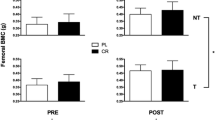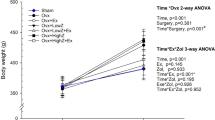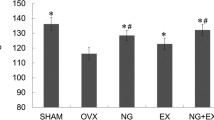Summary
The effects of non-endurance exercise on bone properties were evaluated in 9-month-old sham-operated (SH) and ovariectomized (OVX) rats. The studies were started 3 months postsurgery, after bone mass was decreased in OVX rats. The sham and OVX rats were either kept sedentary (SED) or were trained to run with one of two protocols: 12 m/minute, 50 minutes/day, 4 days/week (low intensity, frequent, EX-1); or 21 m/minute, 40 minutes/day, 1 day/week (moderate intensity, infrequent, EX-2). A group of seven rats evaluated at the beginning of the study served as baseline control. The bone mineral was assessed by the ash weight of the left femur, tibia, and 4th lumbar vertebra. Biomechanical (strength, deformation, stress, strain, and stiffness) and morphometric (length, cortical and medullary area, moment of inertia) properties were evaluated for the right femur. There was a significantly lower bone mineral and mechanical properties in OVX-SED (n=7) than in SH-SED (n=10) rats. The OVX-EX-1 (n=6) rats had higher ash content of femur and tibia than OVX-SED rats, but the change was significant only for tibia. The EX-2 had no effect on the ash content, but femur stress was higher in OVX-EX-2 (n=8) than in OVX-SED rats. The femur yield force and deformation were improved in OVX rats with both exercise protocols, whereas the vertebra ash weight, femur strain, modulus of elasticity, length, cortical area, and moment of inertia were not changed. Non-endurance exercise did not affect bone properties in either SH-EX-1 (n=7) or SH-EX-2 (n=8) groups. We conclude that non-endurance exercise has beneficial effects on established osteopenia in ovariectomized rats.
Similar content being viewed by others
References
Saville PD (1969) Changes in skeletal mass and fragility with castration in the rat: a model of osteoporosis. J Am Geriatr Soc 17:155–166
Kalu DN, Liu C, Hardin RR, Holis BW (1989) The aged rat model of ovarian hormone deficiency bone loss. Endocrinology 124:7–16
Wronski TJ, Cintron M, Dann LM (1988) Temporal relationship between bone loss and increased bone turnover in ovariectomized rats. Calcif Tissue Int 43:179–183
Tuukkanen J, Peng Z, Vaananen HK (1991) Effect of exercise on osteoporosis induced by ovariectomy in rats. Calcif Tissue Int 49:S80
Donahue HJ, Mazzeo RS, Horvath SM (1988) Endurance training and bone loss in calcium-deficient and ovariectomized rats. Metabolism 37:741–744
Block JE, Smith R, Friedlander A, Genant HK (1989) Preventing osteoporosis with exercise: a review with emphasis on methodology. Med Hypotheses 30:9–19
Smith EL, Gilligan C (1991) Physical activity effects on bone metabolism. Calcif Tissue Int 49:S50-S54
Prince RL, Smith M, Dick IM, Price RI, Webb PG, Henderson NK, Harris MM (1991) Prevention of postmenopausal osteoporosis. A comparative study of exercise, calcium, and hormone-replacement therapy. N Engl J Med 325:1189–1204
Barengolts EB, Curry DJ, Bapna M, Kukreja SC (1991) Effects of exercise on bone loss in sham-operated or oophorectomized rats. J Bone Miner Res 6:S105
Barengolts EB, Gajardo HF, Rosol TJ, Kukreja SC (1990) Effects of progesterone on post-ovariectomy bone loss in aged rats. J Bone Miner Res 5:1143–1147
Kiebzak GM, Smith R, Gundberg CC, Howe JC, Sactor B (1988) Bone status of senescent male rats: chemical, morphometric, and mechanical analysis. J Bone Miner Res 3:37–45
Dunnett CW (1955) A multiple comparisons procedure for comparing several treatments with a control. J Am Stat Assoc 50: 1096
Turner RT, Vandersteenhoven JJ, Bell NH (1987) The effects of ovariectomy and 17β-estradiol on cortical bone histomorphometry in growing rats. J Bone Miner Res 2:115–122
Myburgh KH, Noaks TD, Roodt M, Hough FS (1989) Effect of exercise on the development of osteoporosis in adult rats. J Appl Physiol 66:14–19
Currey JD (1988) The effect of porosity and ash content on the Young's modulus of elasticity of compact bone. J Biomech 21: 131–139
Schaffler MB, Burr DB (1988) Stiffness of compact bone: effects of porosity and density. J Biomech 21:13–16
Kiebzak GM, Smith R, Howe JC, Gundberg CM, Sacktor B (1988) Bone status of senescent female rats: chemical, morphometric, and biomechanical analyses. J Bone Miner Res 3:439–446
Simmons ED, Pritzker KPH, Grynpas MD (1991) Age-related changes in the human femoral cortex. J Orthop Res 9:155–167
Albright JA (1987) Bone: physical properties. In: Albright JA, Brand RA (eds) The scientific basis of orthopaedics. New York, p 135
Beyer RE, Huang JC, Wilshire GB (1985) The effect of endurance exercise on bone dimensions, collagen, and calcium in the aged male rat. Experiment Geront 20:315–323
Author information
Authors and Affiliations
Rights and permissions
About this article
Cite this article
Barengolts, E.I., Curry, D.J., Bapna, M.S. et al. Effects of two non-endurance exercise protocols on established bone loss in ovariectomized adult rats. Calcif Tissue Int 52, 239–243 (1993). https://doi.org/10.1007/BF00298726
Received:
Revised:
Issue Date:
DOI: https://doi.org/10.1007/BF00298726




